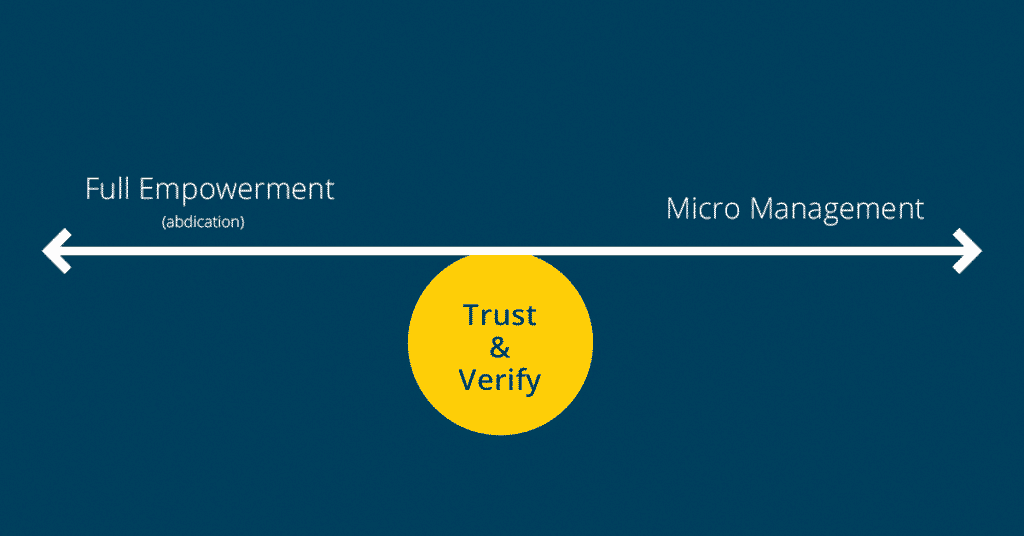4 steps to empowering and overseeing your executive management team
Many CEOs struggle with managing their executive teams, erring on one or the other side of this scale:

On the extreme left is full empowerment, which is a totally hands-off management style. Of course, CEOs trust their executives, but blind trust can be dangerous, and it can also hurt performance. With blind trust, CEOs do not see the need for monitoring and verification steps, so processes, alignment, and ultimately, results are doomed to go astray. When a CEO blindly trusts his Senior Executives, they are effectively empowered to do whatever they want, and if a problem arises, the CEO can plead ignorance.
On the opposite end of the scale is micromanagement, which is where the CEO assumes and performs his Executives’ responsibilities himself. Micromanagement can be costly. It saps productivity and morale, discourages high-performing employees, and limits a company’s growth.
The Balancing Point
There are rare times when leading at the extreme ends of the scale are appropriate. Most of the time, though, the midpoint, which I call “trust and verify,” works best. Here are the most important steps in the trust and verify process:

1. Clearly define roles and expected results.
Expectations are made crystal clear in two areas:
- Each executive’s role and how it will be measured. The specific responsibilities, authority levels, and expected outcomes, including the metrics used to measure success for each position, should be clearly communicated by the CEO and must be understood and accepted by each executive.
- Desired company results. The CEO and his executive team jointly create both current and future multi-year goals in the SMART goal format.
2. Teamwork at the executive level.
It is common for an executive team to be primarily aligned with, and loyal to, their respective functional areas, creating silos and competition for resources between them.
Instead, members of an executive team must believe and act as if their primary allegiance is with their colleagues. When this happens, the executive team is able to make decisions and allocate resources in the best interest of the company, rather than in their own best interests. The CEO must diligently work to create a highly functioning team that holds each member accountable.
3. Regularly align priorities.
The CEO should meet at least monthly with each executive for an “Alignment Session.” The purpose of this session is to verify that the priorities for the next 30 days are in alignment with the CEO’s expectations and company goals. Each executive should not have more than 3-5 top priorities at any given time. Any more is the equivalent of having no priorities. At the end of this session both the executive and CEO should have a clear understanding of the commitments for the upcoming month.
4. Verify reported results.
It is the executives’ responsibilities to prepare a summary of the progress toward their goals, and metrics relating to the performance of their area of responsibility. If goals aren’t met, the CEO has previously set the expectation that a revised plan to meet those goals will also be reviewed at this session. The CEO asks for proof of each executive’s claims and dives into enough detail until he is comfortable that he is receiving accurate information.
5. Trust your gut instinct.
The “gut” is a source of internal wisdom that lies just beyond the conscious mind. Our instincts often kick in when we draw on patterns we’ve seen but can’t articulate. When the CEO is presented with a situation that just doesn’t feel right, he shouldn’t give in. He should keep asking, digging, or doing whatever else is necessary to resolve the conflict between what his mind and gut are telling him.
6. Monitor your culture.
The CEO is directly responsible for developing and maintaining the company’s culture. This is never delegated.
Senior executives, however, have a significant influence on it, and the CEO may not always realize how much a particular executive is affecting it. To ensure that senior executives’ behavior is consistent with the company culture, the CEO can routinely survey employee engagement, provide empowerment through a Key Executive Program, and frequently interact with employees by just walking around.
Yes, managing your Executives is challenging. By implementing these “Trust and Verify” processes, though, you are truly leading your company and positioning yourself to make it more enjoyable, less stressful and more profitable. How do you currently interact with your Management Team? Leave your helpful feedback in the comments below.
Category: Leadership
Tags:


We hold weekly conferences.. same day, same time.. to go over the prior weeks performance. What could have been better? Where do we need to improvise on a plan of action? and To celebrate accomplishments. I use incentives as a great motivator in order to keep my team motivated.